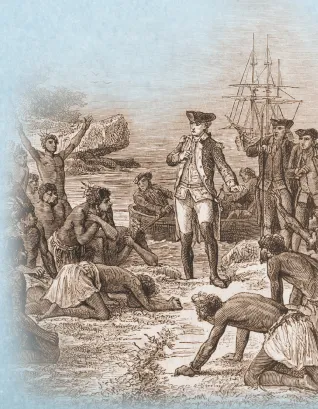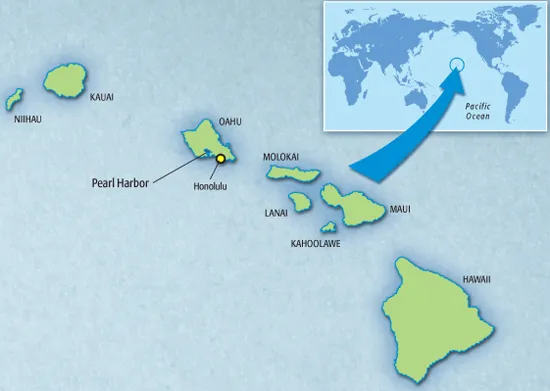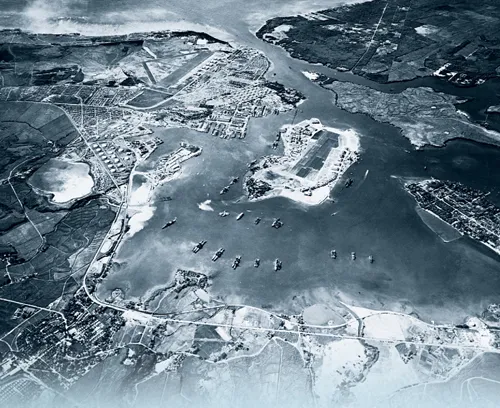
- English
- ePUB (mobile friendly)
- Available on iOS & Android
eBook - ePub
Pearl Harbor
About this book
Pearl Harbor tells the story of how the American naval base at Pearl Harbor in Hawaii became the target of a surprise attack by the Japanese in December 1941.
Frequently asked questions
Yes, you can cancel anytime from the Subscription tab in your account settings on the Perlego website. Your subscription will stay active until the end of your current billing period. Learn how to cancel your subscription.
At the moment all of our mobile-responsive ePub books are available to download via the app. Most of our PDFs are also available to download and we're working on making the final remaining ones downloadable now. Learn more here.
Perlego offers two plans: Essential and Complete
- Essential is ideal for learners and professionals who enjoy exploring a wide range of subjects. Access the Essential Library with 800,000+ trusted titles and best-sellers across business, personal growth, and the humanities. Includes unlimited reading time and Standard Read Aloud voice.
- Complete: Perfect for advanced learners and researchers needing full, unrestricted access. Unlock 1.4M+ books across hundreds of subjects, including academic and specialized titles. The Complete Plan also includes advanced features like Premium Read Aloud and Research Assistant.
We are an online textbook subscription service, where you can get access to an entire online library for less than the price of a single book per month. With over 1 million books across 1000+ topics, we’ve got you covered! Learn more here.
Look out for the read-aloud symbol on your next book to see if you can listen to it. The read-aloud tool reads text aloud for you, highlighting the text as it is being read. You can pause it, speed it up and slow it down. Learn more here.
Yes! You can use the Perlego app on both iOS or Android devices to read anytime, anywhere — even offline. Perfect for commutes or when you’re on the go.
Please note we cannot support devices running on iOS 13 and Android 7 or earlier. Learn more about using the app.
Please note we cannot support devices running on iOS 13 and Android 7 or earlier. Learn more about using the app.
Yes, you can access Pearl Harbor by Stewart Ross, Britannica Digital Learning in PDF and/or ePUB format, as well as other popular books in History & World War II. We have over one million books available in our catalogue for you to explore.
Information
1
Operation Z

Dawn, December 7, 1941: Japanese carrier-borne Mitsubishi dive bombers line up on deck ready for takeoff. A few hours later they were screaming into attack at Pearl Harbor.
Shortly after dawn on December 7, 1941, Commander Mitsuo Fuchida stepped from the flight deck of the Japanese aircraft carrier Akagi and into the cockpit of his Nakajima B5N bomber. Behind him, rows of torpedo bombers and fighters stood in readiness. Alongside the Akagi steamed six other Japanese carriers, their flight decks packed with aircraft. Beyond them, the waiting pilots could see the outlines of the escort battleships and destroyers of the naval Striking Force. Far in front, midget submarines stealthily prepared to approach their target.
The Striking Force was the most powerful aircraft carrier fleet the world had ever seen. It had been assembled for one audacious mission: a surprise air assault on the unsuspecting US Pacific Fleet at its home base in Hawaii. If the mission, known as Operation Z, was successful, then the only force capable of stopping a Japanese offensive into Southeast Asia would be destroyed before war had even been declared.
At 06:00 Commander Fuchida received the order he had been waiting for. His bomber thundered along the flight deck and into the gray skies over the Pacific. A total of 353 Japanese aircraft, dive bombers, torpedo planes, and fighters followed him, their pilots gathering in two waves over the Striking Force, before setting course for the Hawaiian Islands—their target: Pearl Harbor.
2
Pearl Waters
Pearl Harbor is a deep, Y-shaped inlet on the southern coast of Oahu, the third largest of the Hawaiian Islands. This beautiful archipelago stretches in a 2,000-mile (3,000-kilometer) arc across the mid-Pacific. Known in the Hawaiian language as Wai Momi, meaning “Pearl Waters,” the famous harbor lies some 2,385 miles (3,850 kilometers) west of San Francisco, 4,100 miles (6,500 kilometers) east of Tokyo, and 4,600 miles (7,300 kilometers) north of Australia. Such is the strategic importance of this position, it is said to stand at the “crossroads of the Pacific.”
US colony
The British explorer Captain James Cook was the first European to land on the Hawaiian Islands (1778). He found them inhabited by Polynesians who had crossed there in huge seagoing canoes a thousand years before. Following Cook’s visit, these peoples were soon outnumbered by immigrants, mainly from the United States. American business, notably whaling and sugar farming, also moved in, and in 1851 King Kamehameha III of Hawaii put his country under US protection. From this point onward, Hawaiian independence was doomed.

A British expedition, led by the explorer Captain James Cook, lands on the Hawaiian Islands, 1778. As was the European custom at the time, he gave them a Western name, the “Sandwich Islands.”
VOICES
Naming the islands
Besides these six [islands], which we can distinguish by their names, it appeared that the inhabitants … were acquainted with some other islands both to the eastward and westward. I named the whole group the Sandwich Islands, in honor of the Earl of Sandwich.
Captain Cook, 1778. “Hawaii” became the commonly used name in the 19th century.
A US–Hawaii treaty of 1875 increased US influence, and 12 years later the king was forced to accept a government dominated by white sugar farmers. The monarchy collapsed soon afterward. In 1900 the jewels of the Pacific that Mark Twain called “the loveliest fleet of islands that lies anchored in any ocean” were formally annexed to the United States as “overseas territories.”

The Hawaiian Island chain comprises hundreds of islands spread over across the Pacific Ocean. The main islands are shown on this map.
FACT FILE
Cutting the coral
The US Navy first used Honolulu as a base in 1860. Naval Station Hawaii was formally established in 1899–1900. Work began immediately on widening and deepening access to Pearl Harbor by dredging through the coral reef that lay across the port’s narrow entrance. By 1903 the seaway was large enough for the first battleship, USS Wisconsin, to steam into Pearl Harbor.
The US Navy had moved in some time before. During the 1880s, in exchange for allowing Hawaiian sugar into the United States duty-free, the navy was granted the exclusive right to use Pearl Harbor. The entrance was soon dredged to allow large warships to enter. In a flurry of construction, the next few years saw wharves, dry docks, maintenance yards, store rooms, and barracks spring up along the southern shore of the lagoon, opposite Ford Island. The army came in too, setting up an air base at Hickam Field near the harbor entrance. In 1914 it began building the large Schofield Barracks, a building that remains to this day.

Sitting ducks: lines of warships, some in pairs, are clearly visible in this aerial photograph of Pearl Harbor taken shortly before the Japanese attack.
The naval base
For almost a century after its foundation, the United States had looked east, toward Europe, for its friends, enemies, and trading partners. But by the second half of the 19th century this situation was changing. As Japan strove to become a modern, Western-style power, so the United States found its gaze turning more to the west. It was concerned over the future of China, too, and an increasing portion of its trade went to Asia via the ports on America’s western seaboard. In 1898, during the Spanish-American War, the United States became heavily involved in the Philippines and, by 1902, that island country had also become a US colony. It was against this background that the US Navy started expanding its Pearl Harbor base.
VOICES
The importance of Pearl Harbor, 1941
The Navy industrial plant is the major industrial activity in the islands and is much larger than all the civilian industrial plants combined. In a sense, the whole district is the naval base, and unlike continental [US] naval districts, it is almost wholly dependent upon sea communications to the mainland for supplies and personnel.
US Navy plan for the Pearl Harbor District, 1941
After a lull following World War I (1914–18), by the 1930s Pearl Harbor was once again under development. Between 1936 and 1940 more than $100 million was spent upgrading the port, including enlarging the entrance yet again to accommodate the latest battleships and aircraft carriers. It now had a submarine base and the number of naval personnel rose to more than 1,000. In February 1941 the US Navy made the crucial decision to divide its fleet. One half remained in the Atlantic. The other, now known as the Pacific Fleet, had its principal base and operational headquarters at Pearl Harbor.
Changing history
Pearl Harbor was now the very heart of US power in the Pacific, and it was against this highly prestigious site that the Japanese launched their devastating surprise attack at dawn on December 7, 1941. The unannounced strike changed the history of the world. Firstly, it brought the United States into World War II. Congress declared war on Japan the very next day, which soon led to a state of war with Germany and Italy. Secondly, the experience of the war changed the United States from an inward-looking major power to an outward-looking global superpower.
FACT FILE
Ships and planes
On the morning of December 7, 1941, over half the US Pacific Fleet, including all its aircraft carriers, was at sea. Some 99 vessels, large and small, remained in Pearl Harbor. Among their number were eight battleships, eight cruisers, 30 destroyers, and four submarines. In addition there were 390 planes on the surrounding airfields.

Ready for war? US soldiers parade on board a warship exercising in the Pacific, near Hawaii, in September 1940.
3
Two Rising Powers
The gradual breakdown in relations between Japan and the United States began ...
Table of contents
- Cover Page
- Title Page
- Copyright Page
- Contents
- 1: Operation Z
- 2: Pearl Waters
- 3: Two Rising Powers
- 4: The March to War
- 5: Sunday, December 7, 1941
- 6: Hostilities Exist
- 7: Toward Hiroshima
- 8: Ongoing Alert
- Glossary
- Further Information
- Index